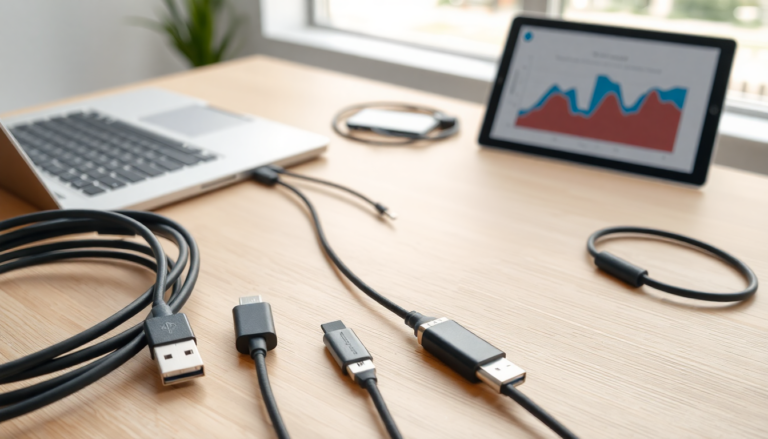Argomenti trattati
When it comes to selecting a USB-C cable, you might be surprised to learn that not all options are created equal. The range in pricing and performance claims can leave consumers scratching their heads: just how much difference can there really be among these seemingly simple products? Well, hands-on evaluations show that the quality of USB-C cables can vary significantly, which directly impacts both charging and data transfer capabilities.
Market Overview and Key Insights
The market for USB-C cables has undergone a swift transformation, with numerous manufacturers stepping up to provide a variety of products tailored to diverse needs. From high-end cables that support fast charging and efficient data transfer to basic models meant for simple charging tasks, understanding these distinctions is essential. The performance of USB-C cables largely hinges on their construction—think wire gauge and the presence of eMarker chips, which communicate the cable’s capabilities to connected devices.
As we look at data from consumer electronics markets, it’s clear that the demand for high-performance USB-C cables is on the rise. Why? As our devices increasingly rely on this standard, users are no longer just searching for charging solutions. They’re looking for cables that can enhance their overall experience with faster data transfers and improved functionality.
For both investors and manufacturers, analyzing sales patterns and understanding consumer preferences has become paramount. The latest data on consumer purchases indicates a strong preference for trusted brands, along with a growing willingness to invest in higher-quality cables that promise durability and performance. Isn’t it fascinating how consumer choices can shape an entire market?
Analysis of Popular Cable Types
Diving deeper into the USB-C cable landscape, we can see key distinctions emerging based on intended use. Charging cables, for instance, may be optimized for power delivery but often lack the necessary wiring for high-speed data transfer. On the flip side, cables designed specifically for data transfer typically boast more robust construction, enabling them to support higher speeds.
Among the notable products available, the Belkin BoostCharge 240-watt charging cable is a standout. It strikes a remarkable balance between quality and performance, all while maintaining a competitive price point. Designed to withstand over 30,000 bends, this cable emphasizes longevity. However, it’s worth noting that while it excels in charging, it doesn’t offer high-speed data transfer or video output capabilities.
Another popular option is the Anker New Nylon 2-pack, which presents great value for those focused on basic charging needs. These braided cables support up to 60 watts and have received positive reviews for their durability. Though they may not be ideal for users in need of high-speed data transfer, they serve as a reliable choice for everyday charging tasks. Have you found your perfect cable yet?
Pricing Trends and Investment Opportunities
When it comes to pricing, USB-C cables are all over the map, influenced by brand reputation, features, and performance capabilities. Recent trends suggest that consumers are more willing than ever to pay a premium for cables that promise performance and durability. As the market continues to grow, the opportunities for investment in high-quality cable manufacturing are also expanding.
For potential investors, grasping the competitive landscape is essential. Products that can adapt to evolving technology standards, like USB4 and Thunderbolt 4, are likely to see a surge in demand. Moreover, brands that prioritize quality and offer clear differentiation in their products will likely thrive. Isn’t it exciting to think about how innovation can drive success in this space?
As the industry evolves, investors should keep a close eye on consumer behavior trends, especially as more users seek cables that deliver both functionality and longevity. Identifying leading brands and emerging technologies will be crucial for capitalizing on this growing market opportunity.
Practical Tips for Buyers
So, how can you navigate the crowded landscape of USB-C cables? When making a purchase, consider the specific needs of your devices. If your primary use case is charging, a basic cable might do the trick. However, for those who frequently transfer large files or connect to external displays, investing in a higher-quality cable is a must.
It’s also wise to check the specifications of the cable regarding its wattage and data transfer capabilities. Look for cables equipped with eMarker chips, as these can provide critical information about performance. Additionally, pay attention to the physical construction of the cable; a well-designed cable usually offers superior durability and performance.
Lastly, be cautious of extremely low-priced cables that could compromise on quality. While they might seem like a great deal, they often lack the necessary features for optimal performance and longevity. Investing in a reputable brand can save you both time and money in the long run. What features are most important to you?
Future Predictions
Looking ahead, the USB-C cable market is poised for continued expansion as more devices adopt this standard. With ongoing technological advancements, the capabilities and features of USB-C cables are likely to evolve, offering consumers even greater performance and versatility.
As manufacturers unveil products promising higher charging speeds and enhanced data transfer rates, consumers will benefit from a broader range of choices. The demand for high-quality cables is expected to remain robust, particularly as users increasingly depend on these connections for their devices. Are you ready to embrace the future of connectivity?
In conclusion, grasping the nuances of USB-C cables is vital for making well-informed purchasing decisions. Armed with the right knowledge, consumers can select products that meet their needs while also uncovering opportunities for investment in this dynamic market.

